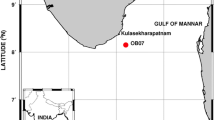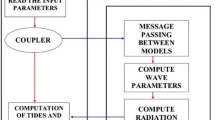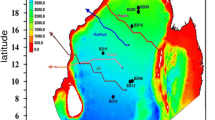Abstract
An accurate prediction of near-shore sea-state is imperative during extreme events such as cyclones required in an operational centre. The mutual interaction between physical processes such as tides, waves and currents determine the physical environment for any coastal region, and hence the need of a parallelized coupled wave and hydrodynamic model. The present study is an application of various state-of-art models such as WRF, WAM, SWAN and ADCIRC used to couple and simulate a severe cyclonic storm Thane that developed in the Bay of Bengal during December 2011. The coupled model (ADCIRC–SWAN) was run in a parallel mode on a flexible unstructured mesh. Thane had its landfall on 30 December, 2011 between Cuddalore and Pondicherry where in-situ observations were available to validate model performance. Comprehensive experiment on the impact of meteorological forcing parameters with two forecasted tracks derived from WRF model, and JTWC best track on the overall performance of coupled model was assessed. Further an extensive validation experiment was performed for significant wave heights and surface currents during Thane event. The significant wave heights measured along satellite tracks by three satellites viz; ENVISAT, JASON-1 and JASON-2, as well in-situ near-shore buoy observation off Pondicherry was used for comparison with model results. In addition, qualitative validation was performed for model computed currents with HF Radar Observation off Cuddalore during Thane event. The importance of WRF atmospheric model during cyclones and its robustness in the coupled model performance is highlighted. This study signifies the importance of coupled parallel ADCIRC–SWAN model for operational needs during extreme events in the North Indian Ocean.













Similar content being viewed by others
References
Bao JW, Wilczak JM, Choi JK, Kantha LH (2000) Numerical simulations of air-sea interaction under high wind conditions using a coupled model: a study of hurricane development. Mon Weather Rev 128:2190–2210
Battjes JA, Janssen JFPM (1978) Energy loss and set-up due to breaking of random waves. In: Proceedings of 16th Conference Coastal Engineering, Hamburg, ASCE, pp 569–587
Bidlot J, Janssen P, Abdalla S (2005) A revised formulation for ocean wave dissipation in CY29R1. Members of Research Department of ECMWF, April 7, R60.9/JB/0516
Booij N, Ris RC, Holthuijsen LH (1999) A third generation wave model for coastal regions. Part I: model description and validation. J Geophys Res 104:7649–7666
Chitra A, Kumar B,Jain IP, Bhar A, Narayana AC (2010) Bottom boundary layer characteristics in the Hooghly estuary under combined wave-current action. Mar Geodesy 33(2):261–281
Chitra A, Kumar B, Prasad, KB (2012) Parameterization of bottom friction under combined wave-tide action in the Hooghly estuary, India. Ocean Eng 43:43–55
Desai SD, Vincent P (2003) Statistical evaluation of the Jason-1 operational sensor data record. Mar Geodesy 26:187–199
Dietrich JC (2010) Development and application of coupled Hurricane wave and surge models for Southern Louisiana. Ph.D thesis, University of Notre Dame, Notre Dame, p 337
Dietrich JC, Bunya S, Westerink JJ, Ebersole BA, Smith JM, Atkinson JH et al (2010a) A high resolution coupled riverine flow, tide, wind, wind wave and storm surge model for southern Louisiana and Mississipi: part II–synoptic description and analyses of Hurricanes Katrina and Rita. Mon Weather Rev 138:378–404
Dietrich JC, Zijlema M, Westerink JJ, Holthuijsen LH, Dawson CN, Luettich RA Jr, Jensen RE, Smith JM, Stelling GS, Stone GW (2011) Modeling hurricane waves and storm surge using integrally-coupled, scalable computations. Coast Eng 58:45–65
Dietrich JC, Tanaka S, Westerink JJ, Dawson CN, Luettich RA Jr, Zijlema M, Holthuijsen LH, Smith JM, Westerink LG, Westerink HJ (2012) Performance of the unstructured mesh SWAN+ADCIRC model in computing Hurricane waves and surge. J Sci Comput 52(2):468–497
Dudhia J (1989) Numerical study of convection observed during the winter monsoon experiment using a mesoscale two-dimensional model. J Atmos Sci 46:3077–3107
Durrant TH, Greenslade DJM, Simmonds I (2009) Validation of Jason-1 and Envisat remotely sensed wave heights. J Atmos Ocean Technol 26:123–134
Eldeberky Y (1996) Non-linear transformation of wave spectra in the near-shore zone. Ph.D thesis, Delft University of Technology, Delft, p 199
Flather RA (2000) Existing operational oceanography. Coast Eng 41:13–40
Funakoshi Y, Hagen SC, Bacopoulus P (2008) Coupling of hydrodynamic and wave models: a case study for a Hurricane Floyd (1999) hindcast. J Waterw Port Coast Ocean Eng 134:321–335
Greenslade DJM, Young IR (2004) A validation of ERS-2 fast delivery significant wave height. BMRC research report 97. Bureau of Metereological Research Centre, Melbourne, p 35
Gunther H, Behrens A (2011) The WAM model–validation document version 4.5.3., Helmholtz-Zentrum Geesthacht. Centre for Materials and Coastal Research, Teltow
Hasselmann S, Hasselmann K, Allender JH, Barnett TP (1985) Computations and parameterizations of the nonlinear energy transfer in a gravity wave spectrum, Part II: parameterizations of the nonlinear transfer for application in wave models. J Phys Oceanogr 15(11):1378–1391
Hersbach H, Janssen PAEM (1999) Improvements of the short fetch behaviour in the WAM model. J Atmos Ocean Technol 16:884–892
Hong SY, Lim JOJ (2006) The WRF single-moment 6-class microphysics scheme (WSM6). J Korean Meteor Soc 42:129–151
Janjic ZI (2001) Nonsingular implementation of the Mellor-Yamada level 2.5 scheme in the NCEP meso model. NCEP office note no. 437, p 61
Janjic ZI (2003) A non-hydrostatic model based on a new approach. Meteorol Atmos Phys 82:271–285
Janjic ZI (2003) The NCEP WRF core and further development of its physical package. In: 5th International SRNWP workshop on non-hydrostatic modeling, Bad Orb, 27–29 October 2003
Janssen PAEM (1992) Experimental evidence of the effect of surface waves on the airflow. J Phys Oceanogr 22:1600–1604
Komen GJ, Hasselmann S, Hasselmann K (1984) On the existence of a fully developed wind-sea spectrum. J Phys Oceanogr 14:1271–1285
Komen GJ, Cavaleri L, Donelan M, Hasselmann K, Hasselmann S, Janssen PAEM (1994) Dynamics and modelling of ocean waves. Cambridge University Press, Cambridge, p 532
Kumar BP, Ruchi K, Dube SK, Sinha PC, Rao AD (2004) Sea state hindcast with ECMWF data using a spectral wave model for typical monsoon months. Nat Hazard 31:537–548
Kumar BP (2010) Reliability based design method for coastal structures in shallow seas. Ind J Geo-Mar Sci 39(4):605–615
Lin YL, Farley RD, Orville HD (1983) Bulk parameterization of the snow field in a cloud model. J Appl Meteor 22:1065–1092
Linsley RK, Franzini JB (1979) Water resources engineering. McGraw Hill Book, New York, p 768
Luettich RA Jr, Westerink JJ (2004) Formulation and numerical implementation of the 2D/3D ADCIRC finite element model version 44.XX, p 74
Madsen OS, Poon YK, Graber HC (1988) Spectral wave attenuation by bottom friction: theory. In: Proceedings of the 21st ASCE coastal, engineering conference, pp 492–504
Medha KS, Sunitha D (2011) Mande MV (2012) Cyclones and depressions over the north Indian Ocean during. Mausam 63(3):369–376
Moon IJ (2005) Impact of a coupled ocean wave-tide-circulation system on coastal modeling. Ocean Model 8:203–236
Murty TS, Henry RF (1983) Tides in the Bay of Bengal. J Geophys Res 88(C10):6069–6076
Punithavathi J, Tamilenthi S, Baskaran R (2012) A study of Thane cyclone and its impacts in Tamil Nadu, India using geographic information system. Arch Appl Sci Res 4(1):685–695
Queffeulou P (2004) Long term validation of wave height measurements from altimeters. Mar Geodesy 27:495–510
Rao AD, Indu J, Murthy MVR, Murty TS, Dube SK (2009) Impact of cyclonic wind field on interaction of surge-wave computations using finite-element and finite-difference models. Nat Hazards 49:225–239
Rao AD, Murty PLN, Jain I, Kankara RS, Dube SK, Murty TS (2012) Simulation of water levels and extent of coastal inundation due to a cyclonic storm along the east coast of India. Nat Hazards. doi:10.1007/s11069-012-0193-6
Rogers WE, Hwang PA, Wang DW (2003) Investigation of wave growth and decay in the SWAN model: three regional-scale applications. J Phys Oceanogr 33:366–389
Skamarock WC, Klemp JB, Dudhia J, Gill DO, Barker DM, Wang W, Powers JG (2005) A description of the advanced research WRF version 2. NCAR tech note, NCAR/TN-468 STR, p 88
Snyder RL, Dobson FW, Elliott JA, Long RB (1981) Array measurements of atmospheric pressure fluctuations above surface gravity waves. J Fluid Mech 102:1–59
Welsh DJS, Bedford KW, Wang R, Sadayappan P (2000) A parallel-processing coupled wave/current/sediment transport model. Technical report ERDC MSRC/PET TR/00-20. US Army Engineer Research and Development Center, Vicksburg
Wolf J, Osuna P, Ashworth M, Roy K (2009) Implementation of a combined wave and current modeling system. CSAR, FOCUS, pp 5–7
Acknowledgments
The authors would like to express their sincere gratitude, and acknowledge the Indian National Centre for Ocean Information Services (INCOIS), Hyderabad under the Ministry of Earth Sciences, Government of India for providing the Wave Rider buoy data and HF Radar Observations. The Doppler Weather Radar images are provided by India Meteorological Department, Chennai. Authors also sincerely thank all the anonymous reviewers for their constructive critical comments to improve the overall quality of this manuscript.
Author information
Authors and Affiliations
Corresponding author
Rights and permissions
About this article
Cite this article
Bhaskaran, P.K., Nayak, S., Bonthu, S.R. et al. Performance and validation of a coupled parallel ADCIRC–SWAN model for THANE cyclone in the Bay of Bengal. Environ Fluid Mech 13, 601–623 (2013). https://doi.org/10.1007/s10652-013-9284-5
Received:
Accepted:
Published:
Issue Date:
DOI: https://doi.org/10.1007/s10652-013-9284-5




